2.06.2021
NASA evaluating schedule, launch date forecasts for Artemis 2
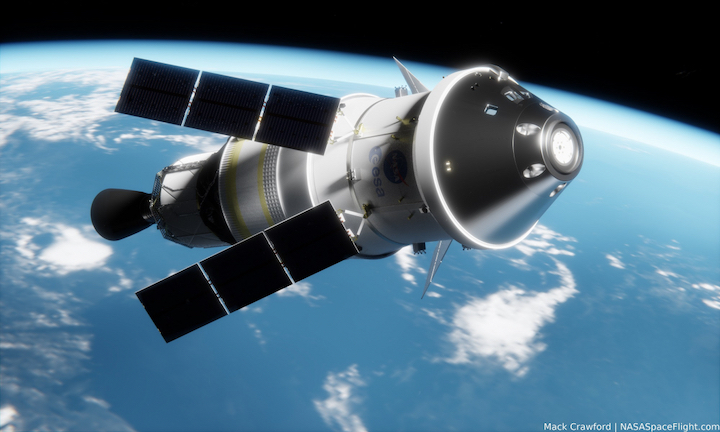
NASA is currently forecasting that Artemis 2 will be ready to launch no earlier than (NET) September 2023, but similar to attempting to forecast when Artemis 1 will be ready to launch, there is also uncertainty in when Artemis 2 might fly. The second joint test flight of NASA’s Orion and Space Launch System (SLS) vehicles will be the first to fly a four-person crew after Artemis 1 goes on an uncrewed lunar orbit mission.
Assembly, integration, and testing of the Artemis 2 Orion and SLS flight hardware continues in the U.S. and Europe independently of Artemis 1 for now, but some Orion hardware from Artemis 1 is still expected to be needed for reuse. The global COVID pandemic is also still having an effect on production activities, which could also affect when Artemis 2 is ready to launch.
Monitoring Orion hardware delivery progress and Artemis 1 schedule
Currently, Artemis 2 is forecast to fly in the second half of 2023 after the long-awaited Artemis 1 uncrewed test flight. The timing for both is uncertain, and the Artemis 2 schedule depends on when Artemis 1 launches because some Orion flight hardware is planned to be used for both missions.
All the flight hardware for Artemis 1 is staged in different locations around the Kennedy Space Center launch site, where Exploration Ground Systems (EGS) is handling launch processing. The final stacking sequence is expected to pick up in early-June with the mating of the SLS Core Stage to its twin Solid Rocket Boosters (SRBs), but the Artemis 1 launch readiness date itself also depends on how smoothly the first-time integrated testing and checkout proceeds; recent estimates place readiness for launch anywhere between November 2021 and March 2022.
Meanwhile, assembly and testing of the Artemis 2 flight hardware continues around the U.S. and in Europe, with some elements already in storage waiting to be called up when needed. But the time between flights is still uncertain.
“It’s tricky when you talk about a specific period of time between Artemis 1 and Artemis 2,” Tom Whitmeyer, Deputy Associate Administrator for Exploration Systems Development (ESD), said in a May 13 interview.
“Where we are is we’re trading back and forth between when the [Orion] Service Module shows up and is ready to integrate with the Crew Module and some of the avionics that we need to put in the Crew Module, but the tricky part is that we constantly re-evaluate our schedule and there’s ways that we can kind of change the order and sequence of when things are installed in the vehicle.”

Credit: Airbus Defence and Space.
(Photo Caption: One of the hypergolic propellant tanks for the second Orion European Service Module (ESM) is seen in October 2020 during integration activities in Bremen, Germany. Prime contractor Airbus Defence and Space is finishing integration and functional testing for a planned delivery to KSC later this year.)
The Orion Service Module is composed of the European Service Module (ESM) and the Crew Module Adapter (CMA). ESM Flight Model 2 (FM-2) is currently in final assembly at prime contractor Airbus Defence and Space’s Assembly, Integration, and Testing facility in Bremen, Germany.
Once final assembly and functional testing are complete, ESM FM-2 will be flown to KSC where Orion prime contractor Lockheed Martin is building the CMA and Crew Module. According to NASA’s Fiscal Year 2022 (FY 2022) budget request that was released on May 28, the ESM is scheduled to arrive at KSC in August 2021.
Lockheed Martin’s Orion Assembly, Test, and Launch Operations (ATLO) team will complete preparations to mate the ESM and CMA and test the assembled Service Module. In parallel with the Service Module build-up, Lockheed Martin will continue integration and testing of the Crew Module ahead of mating the two completed Crew and Service Modules.
U.S. government watchdog organizations have cited comments from space agency officials when noting a minimum of 20 months are necessary between Artemis 1 and Artemis 2 to reuse avionics equipment. “According to program officials, NASA will require a minimum of 20 months to refurbish and install these reused components, complete the crew and service module, and complete the EGS prelaunch processing activities,” the Government Accountability Office said in a report published in December 2020.
Most of the work involves tasks that need to be performed after the reused avionics are installed — finishing outfitting of the CMA, ESM, and Crew Module, assembling and testing them as an integrated Crew and Service Module, and then assembling and testing of Orion with SLS. But there’s also a long lead time required for those reused Orion components.
“I always avoid things like 20 months here, 20 months there because it’s really not what we’re looking at,” Whitmeyer said. “The two things that we’re looking at are completing delivery of the hardware for Artemis 2 and completing the Artemis 1 mission and getting the [Orion] hardware off of Artemis 1 and using it for Artemis 2.”
The FY 2022 budget request says the current launch readiness date for Artemis 2 is now no earlier than September 2023. Given the uncertainties, both Artemis 1 and Artemis 2 dates are still being reviewed. “NASA Leadership will evaluate the results of the assessment during Orion’s Systems Integration Review (SIR) in May 2021 leading to Key Decision Point D (KDP-D) review in July 2021 before updating the Artemis I and II (Launch Readiness Dates),” the budget request document said.
Delivery of the Artemis 2 ESM is expected in the middle of northern hemisphere summer, but the lingering effects of the COVID-19 pandemic could still interfere. “For Orion on Artemis 2, maybe even more so than on Artemis 1, some of the challenges we’ve seen have been COVID-related,” Whitmeyer noted.
“With COVID impacts, it’s country by country, and you can have shutdowns and then non-shutdowns, and so we’re constantly monitoring the status of some of this hardware coming together for the Artemis 2 mission. The ESA Service Module is sitting in Bremen, Germany, right now, and they are finishing up most of the work on it. It’s not [fully] complete, but it’s pretty far along.”
“I’m really proud of the Europeans; they’re doing a great job getting the Service Module [completed], and we’re expecting it here this summer,” he added.
The Artemis 2 Crew Module and Crew Module Adapter are being assembled by Lockheed Martin’s ATLO team in the Armstrong O&C Building at KSC. “[The Crew Module] is being outfitted as we speak,” Whitmeyer said.

Credit: NASA/Kim Shiflett.
(Photo Caption: Fluid tubing and wire harnesses for the Artemis 2 Orion Crew Module are obscured by coverings in the Operations and Checkout Building at KSC in February 2021. Orion prime contractor Lockheed Martin is assembling the Crew Module and Crew Module Adapter elements of the spacecraft, where eventually the Crew and Service Modules will be fully assembled and checked out prior to handover to Exploration Ground Systems for launch integration.)
“They’re doing some work to get the ECLSS (Environmental Control and Life Support System) installed; that’s a first-time [activity] because Artemis 2 is our test flight with a crew and so that’s the work that is taking place to continue outfitting the capsule for Artemis 2.”
The CMA recently completed proof testing of its tube welds and is scheduled to be fully outfitted and ready for functional testing in September 2021.
Artemis 2 Orion Crew Module avionics reuse
Artemis 2 will be a crewed test flight to checkout Orion’s ECLSS and other crew systems like display units, hand controllers, and audio communication equipment. In contrast to Artemis 1, where SLS will complete a full trans-lunar injection (TLI) for the uncrewed Orion, on Artemis 2, SLS will leave the Orion and four-person crew in an elliptical high Earth orbit.
The trajectory will set up Orion to fly a “hybrid triple” orbit mission. After the first low Earth orbit, the SLS upper stage, the Interim Cryogenic Propulsion Stage, will fire to place the vehicle in a 42-hour long high Earth orbit.
Orion will separate from SLS and use that single high Earth orbit for an extended ECLSS checkout; at the end of the orbit, Orion will burn its main engine to add the extra velocity needed for TLI. The third and final orbit of the mission will be a lunar flyby followed by a return to Earth for re-entry, descent, and splashdown.

Credit: Mack Crawford for NSF.
(Photo Caption: The Artemis 2 Orion faces its SLS Interim Cryogenic Propulsion Stage upper stage during a proximity operations demonstration test planned on the first day of the mission. The Artemis 2 flight crew will manually turn their spacecraft around and fly a close range approach to the stage to gather data on the handling qualities of the Orion flight control system for future rendezvous and docking missions.)
More recently, NASA added a proximity operations demonstration test to the Artemis 2 flight. After evaluating options to accelerate development of some hardware and software from the full rendezvous, proximity operations, and docking (RPOD) system, NASA decided not to do that; instead, the flight crew will manually pilot a test using the SLS Interim Cryogenic Propulsion Stage (ICPS) upper stage as the target after separation.
“The astronauts will pilot Orion’s flight path and orientation in manual mode,” NASA’s September 2020 Artemis Plan document stated.
“The crew will use onboard cameras and the view from the spacecraft’s windows to line up with the ICPS as they approach and back away from the stage to assess Orion’s handling characteristics. The demonstration will provide performance data and operational experience that cannot be readily gained on the ground.”
The RPOD system is expected to fly for the first time on Artemis 3 to demonstrate a fully automated rendezvous and docking. “The [Orion] program started the Artemis 3 docking system critical design review (CDR) on March 30, 2021. The review will complete the vehicle design and determine readiness for full-scale fabrication, assembly, integration, and test,” the FY 2022 budget document said.
Originally, at least three years were planned between the first two SLS-launched Orion missions to the Moon, which allowed time for all the primary Orion avionics in the Crew Module to be reused from the first flight to the second. When the second flight was moved from the SLS Exploration Upper Stage back to the ICPS in 2018, the time between flights was reduced; NASA’s Orion Program accelerated the purchase of a second set of core avionics to allow most of the assembly and checkout testing of the Crew Module to continue independently of the Artemis 1 timeline.
“The core [avionics] are most of the primary [boxes] that allows us to [do] most of the functional integration checkout of Orion, so it’s power distribution units, it’s [flight] computers,” Whitmeyer said. “We did get a second set, they’re available, and that’s what we’re putting on the vehicle right now.”
The non-core avionics can be installed later in the Crew Module integration and testing sequence, and those would still be taken off the Artemis 1 spacecraft after it splashes down. “There’s [the] non-core avionics like a phased-array antenna, Orion IMUs (Inertial Measurement Units)… those are the type of things that we would transition from the first flight to the second flight,” Whitmeyer noted.
A second set of non-core avionics was also purchased but later than the core set, and if Artemis 1 flies soon enough, the first set of non-core avionics boxes would still become available before the second set. “The most likely scenario is we’ll finish up Artemis 1, we’ll take those non-cores off Artemis 1 and put them on Artemis 2, and that’s what we anticipate will happen,” Whitmeyer said.
“We also have on order [the] additional non-cores if for whatever reason we fall really far behind on Artemis 1 by a couple of months. Those would show up, and we would just use the backup set of non-cores.”
Artemis 1 is nominally planned to be a four or six-week long mission, so there would still be a significant amount of time after launch before those Crew Module avionics would be available for refurbishment and reuse. The second set of non-core avionics are projected to be delivered to KSC in early 2022; if Artemis 1 still has not launched by that time, delivery of that backup set of avionics boxes would allow the Artemis 2 Orion schedule to be uncoupled from the Artemis 1 mission.

Credit: NASA/Glenn Benson.
(Photo Caption: The partially-outfitted Orion Crew Module Adapter for Artemis 2 is moved out of clean room in the Operations and Checkout Building at KSC in June 2020. Tube welding is done in the clean room on the individual Crew Module and Crew Module Adapter (CMA) elements during assembly and also on the integrated Service Module after the CMA and European Service Module are integrated.)
NASA’s FY 2022 budget request document says that the non-core avionics from the Artemis 1 spacecraft are expected to be delivered to KSC after refurbishment in spring 2022.
Whitmeyer also noted that Orion and Lockheed Martin are looking at ways to reorganize blocks of work around when either set of the non-core Crew Module avionics becomes available for Artemis 2. “We constantly re-evaluate our schedule, and there’s ways that we can kind of change the order and sequence of when things are installed in the vehicle,” he said.
“I’m always reluctant to get into ‘X’ number of months because by the time I’m done telling you that I will have figured out some other thing. We’re working with the Orion folks to look at our workforce loading at the Cape, and depending on what we see in terms of the actual Artemis 1 launch date, we have different types of ways to expedite recovery operations and bring the avionics back to the O&C.”
“When I look at getting the avionics off Artemis 1 and getting them onto Artemis 2, I’ve got a couple of different options of when I re-integrate them into the flow,” Whitmeyer added.
Other Artemis 2 hardware assembly and integration also continues
In addition to the Orion flight hardware build up for Artemis 2, the SLS program is assembling the elements of its second vehicle, and EGS is planning on upgrades to the KSC ground support infrastructure for the first crew launch. Within the SLS hardware elements, the Core Stage is the most complicated, but is not currently pacing the overall schedule.
“Core Stage-2 is working its way through MAF (Michoud Assembly Facility), and we’re actually making pretty good progress with engine section complete later this year,” Whitmeyer said. “That’s currently not on the critical path, though I am always careful to make sure we always take these things a step at a time.”
On May 24, Boeing lifted the Core Stage-2 forward skirt into place on top of the liquid oxygen (LOX) tank in a stacking cell at MAF in New Orleans. The second structural mate was the last one for the forward join, which won’t be complete until after internal power, data, and propulsion system connections are made.

Credit: NASA/Michael DeMocker and Eric Bordelon.
(Photo Caption: The forward skirt for Core Stage-2 is lifted into place on top of the liquid oxygen tank as a part of final assembly of the stage elements. Structural assembly and outfitting both inside and outside the stage will continue over the next year with completion currently forecast for some time on FY 2022.)
Meanwhile, Northrop Grumman has completed the 10 solid rocket motor segments for Artemis 2 at their Promontory production facility in Utah, and they are in storage there until they are needed for launch integration. Northrop Grumman is also processing the second set of forward and aft assemblies for the boosters at KSC; those assemblies will be mated with the motor segments after they are shipped by rail to the launch site.
Assembly and outfitting of the stage and spacecraft adapters is also in work by the SLS Program at the Marshall Space Flight Center in Huntsville, Alabama. The Launch Vehicle Stage Adapter (LVSA), which connects the SLS Core Stage and Interim Cryogenic Propulsion Stage, and the Orion Stage Adapter (OSA), which connects the ICPS upper stage to Orion, are being manufactured for availability next year. United Launch Alliance was also expected to complete the ICPS for Artemis 2 in 2022.
In between Artemis 1 and Artemis 2, EGS is planning on modifications and upgrades to Mobile Launcher-1 (ML-1), the VAB, and in the Launch Pad 39B area. With crewed flights scheduled to begin on Artemis 2, an Emergency Egress System needs to be integrated with ML-1’s launch umbilical tower and with support structures at Pad 39B.
The system would allow personnel up on the Mobile Launcher’s umbilical tower at the pad, while the vehicle is fueled during the final countdown, to make an emergency evacuation away from the tower to bunkers and protection in the pad perimeter area. In addition to modifications to support emergency egress from the ML tower, other changes are planned for ML-1 prior to its supporting Artemis 2.
The KSC work solicitation in the request for proposals (RFP) notes that the scope of the work includes: “Structural modifications to ML-1 to add platforms for the emergency egress system, adding ground cooling systems, relocating a rest room, adding fire detection systems, modifying the fire suppression systems, camera systems, and other facility systems, and building and installing new cables that are potted and molded for several critical systems including the launch release system, hazardous gas detection system in order to safely launch astronauts for Artemis 2.”
Some of the work tasks are planned on ML-1 prior to the Artemis 1 launch, but approximately 150 days of work are planned on tasks that would be performed in between Artemis 1 and Artemis 2.
Another EGS project planned in between the two launches are modifications to Environmental Control Systems (ECS) in the VAB. “To support launches post Artemis I, modifications are planned to the ECS that will enable it to support a Block 1 and Block 1B vehicle,” the FY 2022 budget request document says.
“This will require modifications to the existing circuits; however, these circuits must be maintained throughout the entire Artemis I launch campaign.” EGS is looking at ways to ensure those modifications can be completed without interfering with the schedule to Artemis 2 launch readiness.
Quelle: NS
----
Update: 19.06.2021
.
NASA and Boeing Progress Toward July Launch of Second Starliner Flight Test
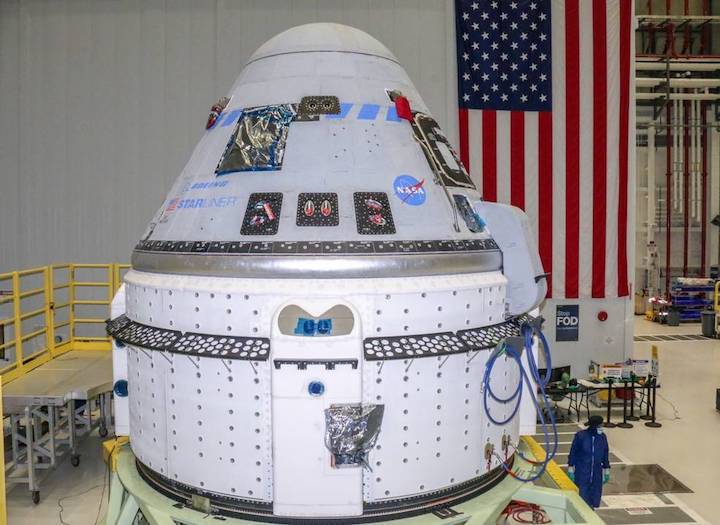
NASA and Boeing are continuing preparations ahead of Starliner’s second uncrewed flight to prove the system can safely carry astronauts to and from the International Space Station.
Teams inside the Starliner production factory at NASA’s Kennedy Space Center in Florida recently began fueling the Starliner crew module and service module in preparation for launch of Orbital Flight Test-2 (OFT-2) at 2:53 p.m. EDT on Friday, July 30. The fueling operations are expected to complete this week as teams load propellant inside the facility’s Hazardous Processing Area and perform final spacecraft checks.
Once fueling operations are complete, teams from Boeing and United Launch Alliance (ULA) will prepare to transport Starliner to the Vertical Integration Facility (VIF) at Space Launch Complex-41 on Cape Canaveral Space Force Station for mating with ULA’s Atlas V rocket. Beginning this week, ULA will begin stacking, or assembling, the Atlas V rocket at the VIF during an operation called Launch Vehicle on Stand (or LVOS).
In preparation for Starliner’s next flight, NASA and Boeing have closed all actions recommended by the joint NASA-Boeing Independent Review Team, which was formed as a result of Starliner’s first test flight in December 2019. The review team’s recommendations included items relating to integrated testing and simulations, processes and operational improvements, software requirements, crew module communication system improvements, and organizational changes. Boeing has implemented all recommendations, even those that were not mandatory, ahead of Starliner’s upcoming flight.
“I am extremely proud of the NASA and Boeing Starliner teams as they methodically work toward the OFT-2 mission next month with final checks of the crew module and service module hardware and software as we prepare for this important uncrewed test mission,” said Steve Stich, NASA Commercial Crew Program manager. “Closing all of the Independent Review Team findings for the software and communications systems is a huge milestone for the Commercial Crew Program and included many long hours of testing and reviews by our dedicated Boeing and NASA teams during this Covid-19 pandemic.”
In the weeks ahead, mission control teams in Florida and Texas will continue conducting simulated mission dress rehearsals for the uncrewed OFT-2 and follow-on crewed missions. Starliner’s landing and recovery teams also will perform an on-site checkout of one of the vehicle’s landing zones.
During the OFT-2 mission, Starliner will test its unique vision-based navigation system to autonomously dock with the space station and deliver approximately 440 pounds, or roughly 200 kilograms, of cargo and crew supplies for NASA. Starliner is expected to spend five to 10 days in orbit before undocking and returning to Earth, touching down on land in the western United States.
Providing Starliner’s second uncrewed mission meets all necessary objectives, NASA and Boeing will look for opportunities toward the end of this year to fly Starliner’s first crewed mission, the Crew Flight Test (CFT), to the space station with NASA astronauts Barry “Butch” Wilmore, Nicole Mann, and Mike Fincke on board.
Boeing currently is refurbishing the first Orbital Flight Test crew module for crewed flight along with outfitting a brand new service module. The CFT Atlas V hardware is expected to arrive in Florida for processing next week as teams prepare for both missions in parallel.
Boeing has designed and developed the Starliner spacecraft in support of NASA’s Commercial Crew Program to provide safe and sustainable commercial transportation services for crew and cargo to the International Space Station and low-Earth orbit destinations.
NASA’s Commercial Crew Program is working with industry through a public-private partnership to provide safe, reliable, and cost-effective transportation to and from the International Space Station, which will allow for additional research time and will increase the opportunity for discovery aboard humanity’s testbed for exploration. The space station remains the springboard to space exploration, including future missions to the Moon and eventually to Mars.
Quelle: NASA
----
Update: 23.06.2021
.
ULA Begins Stacking Atlas V for Boeing's Starliner OFT-2 Launch, as Second Booster Arrives for First Crewed
Flight
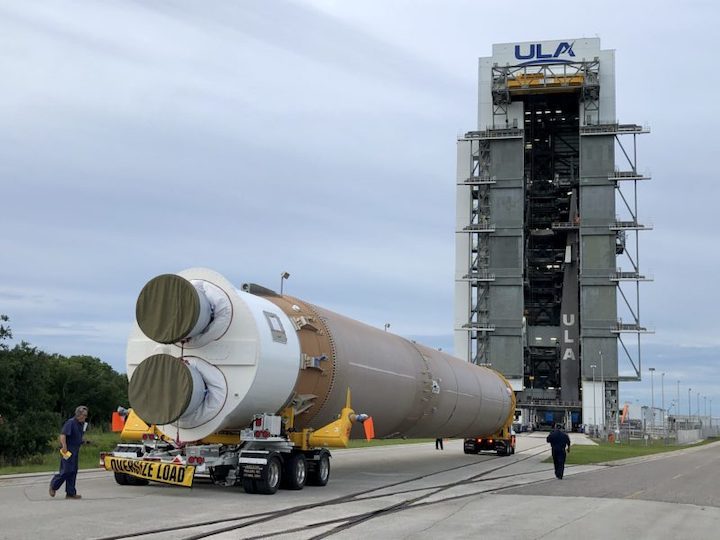
United Launch Alliance (ULA) is quite busy at Cape Canaveral Space Force Station in Central Florida, where the company is currently stacking the Atlas V rocket which will launch Boeing’s second un-crewed Orbital Flight Test of their Starliner space capsule under contract with NASA’s Commercial Crew Program to the International Space Station (ISS).
And right on the heels of that, the Atlas V for Starliner’s first crewed mission, the Crew Flight Test (CFT), just arrived today at the spaceport via the company’s transport ship from Decatur, AL.
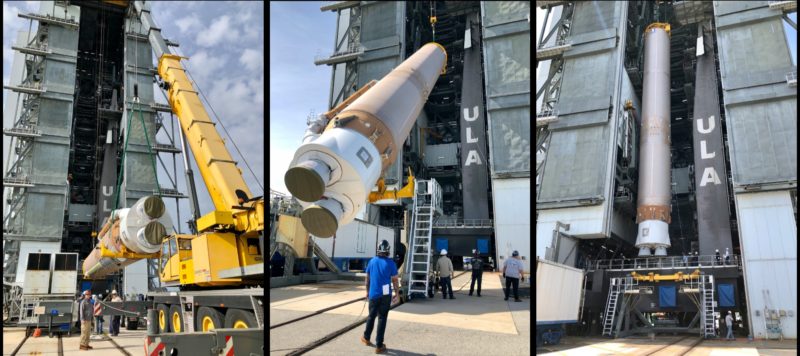
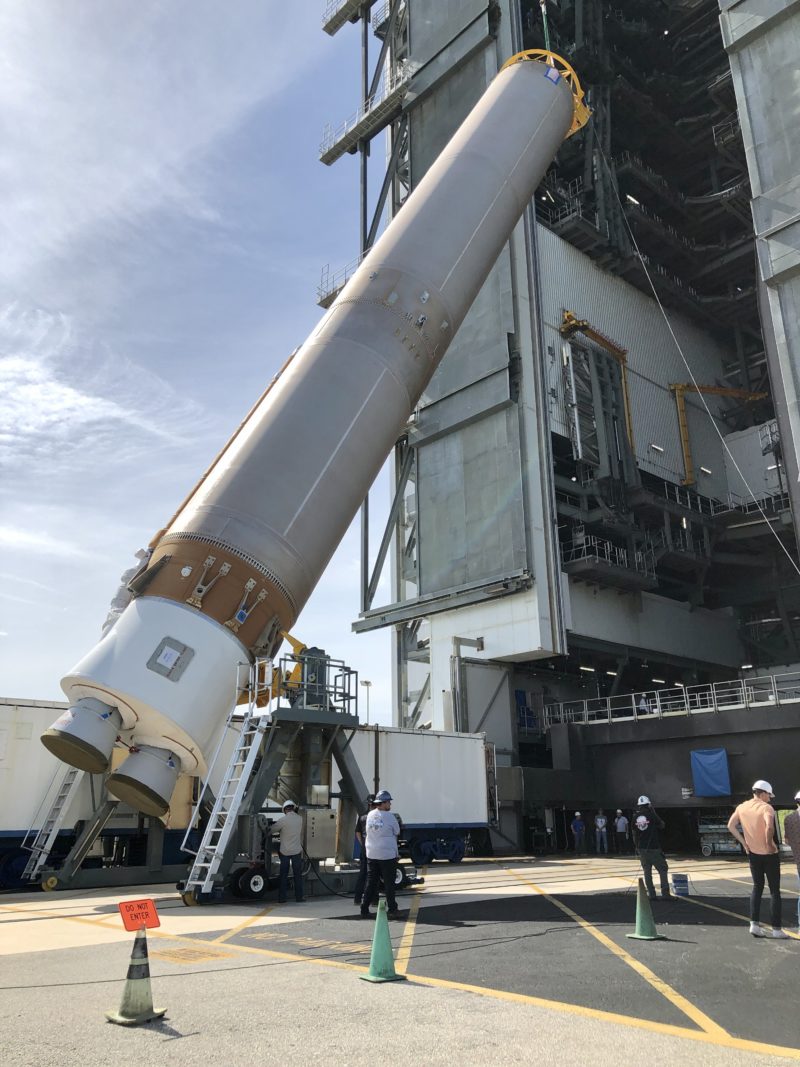
Over the last few days, ULA transported the 107-foot-long first stage OFT-2 booster to the Vertical Integration Facility at launch complex 41, and have since raised it vertical and hoisted it atop the rocket’s Mobile Launch Platform. Known collectively as the Launch Vehicle on Stand (LVOS) milestone, ULA will now begin mating two AJ60 solid rocket boosters and the Centaur upper stage with dual RL10A-4-2 engines to the booster, before attaching the spacecraft itself in July for a planned July 30 launch at 2:53pm EDT (1853 UTC).
The mission comes following a questionable first Orbital Flight Test in 2019, where the spacecraft suffered a software timing anomaly shortly after launch which prevented it from ever reaching the ISS. And while they did save the spacecraft and were able to conduct various other test objectives, and brought the spacecraft back to Earth safely, the bottom line is they still have yet to prove it can safely rendezvous with the ISS, which is the whole reason NASA awarded them a multi-billion dollar contract years ago along with SpaceX, who has now been flying crews on their Dragon spacecraft for over a year (and with a smaller dollar amount contract).
Despite an incomplete OFT-1 mission, Starliner successfully demonstrated its propulsion systems, its communications systems, its Guidance, Navigation and Control (GNC), its Environmental Control and Life Support System (ECLSS) and—through a series of in-flight extension/retraction tests—its NASA Docking System (NDS).
And although NASA noted that an actual ISS docking was not a mandatory requirement to “crew-certify” Starliner, and pointed out that had a crew been aboard OFT-1 they could have taken manual control and likely overcome the automated timing problem, it became increasingly likely as 2020 dawned that another uncrewed flight would need to take place.
A High Visibility Close Call (HVCC) Review, led by NASA Associate Administrator for Human Exploration and Operations Kathy Lueders and Commercial Crew Program Manager Steve Stich, revealed a worrisome number of technical and organization root causes for the troubled mission. In March 2020, a joint NASA/Boeing Independent Review Team (IRT) found that three principal anomalies had plagued the flight. Two were classified as “software coding errors”.
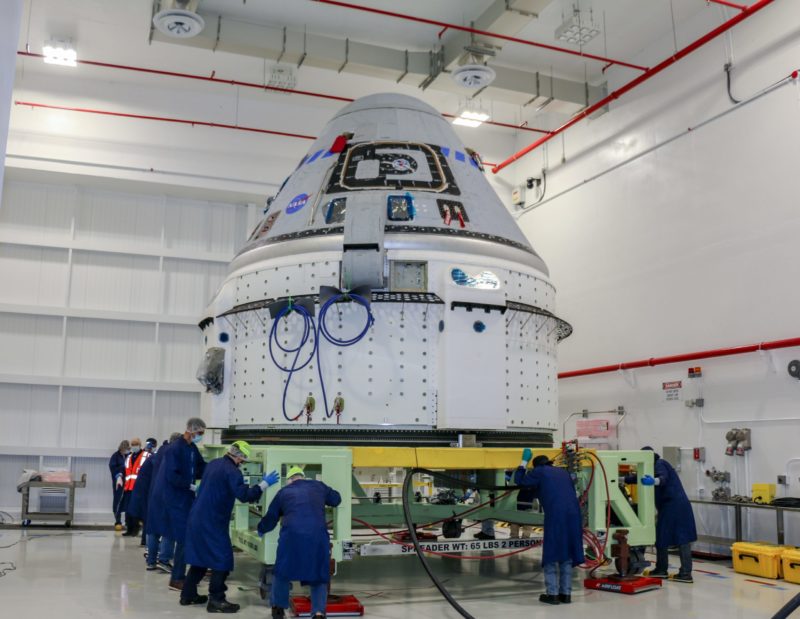
You can read more in depth details on the issues HERE in our prior reporting, along with the resolutions. Bottom line now is both Boeing and NASA are confident the issues are resolved, and look ahead to the second OFT as soon as July 30, which is set to last approximately a week and will dock and undock autonomously at International Docking Adapter (IDA)-2, on the forward-facing port of the station’s Harmony node.
The spacecraft will also deliver approximately 760 pounds of payload, including 440 pounds of NASA cargo and supplies for the current ISS crew members, a commemorative U.S. flag that will remain aboard the ISS until it returns to Earth on Starliner’s CFT, and provisions like clothes and sleeping bags for CFT astronauts Barry “Butch” Wilmore, Nicole Mann and Mike Fincke.
Boeing’s 320 pounds of cargo includes other special commemorative items for Starliner employees, suppliers and partners who have worked to get the spacecraft flying safely. A card that Boeing’s founder, Bill Boeing, signed and used to travel the United States by air will also fly on OFT-2, along with Silver Snoopy pins, which are presented by astronauts to people that directly contribute to the success of the U.S. human spaceflight program.
Rosie the Riveter commemorative coins will also be onboard, created to celebrate last year’s passage of the Rosie the Riveter Congressional Gold Medal Act, which honors 19 million American women who worked in the aerospace industry as men went off to fight in World War II.
Both the Starliner crew module and service module are now fueled for flight, and are undergoing final preparations at neighboring Kennedy Space Center. NASA and Boeing have closed all actions recommended by the joint NASA-Boeing Independent Review Team, as well, which was formed as a result of Starliner’s first OFT.
In the meantime, mission control teams in Florida and Texas are conducting simulated mission dress rehearsals for OFT-2 and future crewed flights. Starliner’s landing and recovery teams will also do an on-site checkout of one of the vehicle’s landing zones.
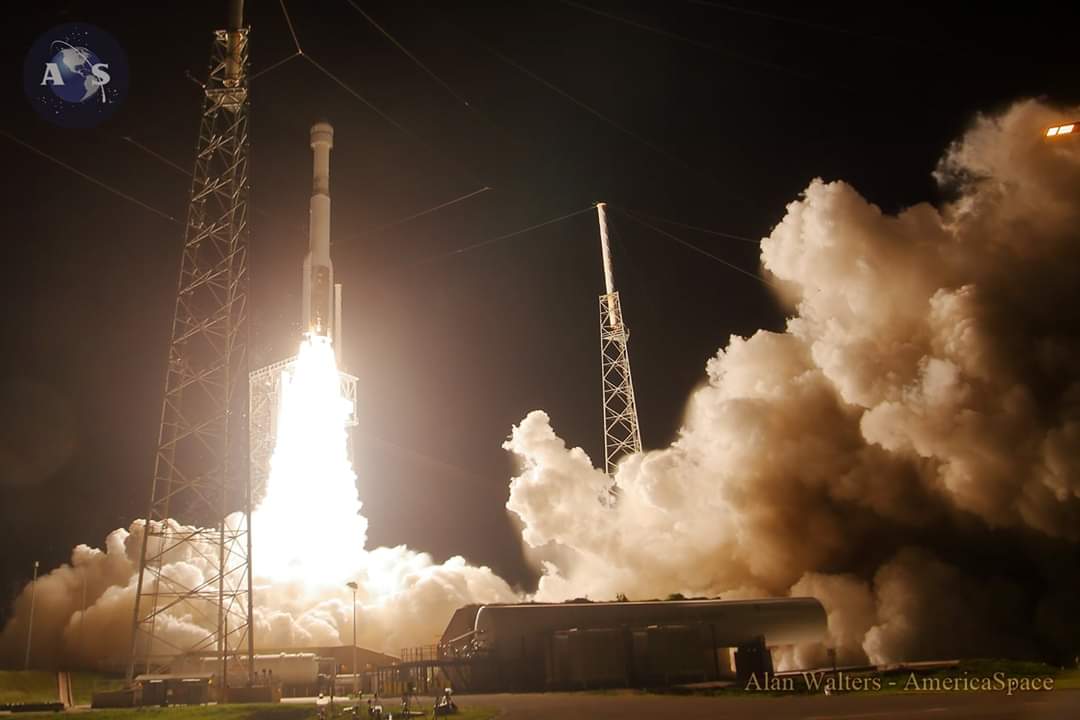
“I am extremely proud of the NASA and Boeing Starliner teams as they methodically work toward the OFT-2 mission next month with final checks of the crew module and service module hardware and software as we prepare for this important uncrewed test mission,” said Steve Stich, NASA Commercial Crew Program manager. “Closing all of the Independent Review Team findings for the software and communications systems is a huge milestone for the Commercial Crew Program and included many long hours of testing and reviews by our dedicated Boeing and NASA teams during this Covid-19 pandemic.”
Assuming that the mission runs without significant wrinkles, the way will be clear for the CFT with Commander Barry “Butch” Wilmore, Pilot Nicole Mann and Joint Operations Commander (JOC) Mike Fincke, before the end of the year.
Quelle: AS
----
Update: 18.07.2021
.
Editor's Note: This advisory was updated on July 16 to correct the time and date by which media must contact the Kennedy newsroom to particpate in the July 27 Prelaunch News Conference.
NASA will provide coverage of the upcoming prelaunch, launch, and docking activities for the agency’s Boeing Orbital Flight Test-2 (OFT-2) mission to the International Space Station. Scheduled to launch at 2:53 p.m. EDT Friday, July 30, OFT-2 is the second uncrewed flight for Boeing’s CST-100 Starliner spacecraft as part of the agency’s Commercial Crew Program.
Starliner will launch on a United Launch Alliance (ULA) Atlas V rocket from Space Launch Complex-41 at Cape Canaveral Space Force Station in Florida. About 31 minutes after launch, Starliner will reach its preliminary orbit. It is scheduled to dock to the space station at 3:06 p.m. Saturday, July 31. Prelaunch activities, launch, and docking will air live on NASA Television, the NASA app, and the agency’s website.
The spacecraft will carry more than 400 pounds of NASA cargo and crew supplies to the space station and return to Earth with more than 550 pounds of cargo, including reusable Nitrogen Oxygen Recharge System (NORS) tanks that provide breathable air to station crew members.
OFT-2 will demonstrate the end-to-end capabilities of the Starliner spacecraft and Atlas V rocket from launch to docking to a return to Earth in the desert of the western United States. The uncrewed mission will provide valuable data toward NASA certifying Boeing’s crew transportation system for regular flights with astronauts to and from the space station.
The deadline has passed for media accreditation for in-person coverage of this launch. More information about media accreditation is available by emailing: ksc-media-accreditat@mail.nasa.gov.
NASA has updated its coronavirus (COVID-19) policies to remain consistent with new Centers for Disease Control and Prevention (CDC) guidance. Credentialed media will receive additional details from the media operations team at NASA’s Kennedy Space Center in Florida.
NASA’s Boeing OFT-2 mission coverage is as follows (all times Eastern):
Thursday, July 22
6 p.m. - Flight Readiness Review (FRR) Media Teleconference at Kennedy (or no earlier than one hour after completion of the FRR), with the following participants:
- Kathryn Lueders, associate administrator, Human Exploration and Operations Mission Directorate at NASA
- Norm Knight, director, Flight Operations Directorate
- Steve Stich, manager, NASA’s Commercial Crew Program
- Joel Montalbano, manager, NASA’s International Space Station Program
- John Vollmer, vice president and program manager, Boeing Commercial Crew Program
Media may ask questions via phone only. For the dial-in number and passcode, please contact the Kennedy newsroom no later than 5:30 p.m. Thursday, July 22, at: ksc-newsroom@mail.nasa.gov.
Tuesday, July 27
TBD – Prelaunch News Conference on NASA TV (or no earlier than one hour after completion of the Launch Readiness Review):
- Steve Stich, manager, NASA’s Commercial Crew Program
- Joel Montalbano, manager, NASA’s International Space Station Program
- Jennifer Buchli, deputy chief scientist, NASA’s International Space Station Program
- John Vollmer, vice president and program manager, Boeing Commercial Crew Program
- Gary Wentz, vice president, Government and Commercial Programs, ULA
- Will Ulrich, launch weather officer, U.S. Space Force, 45th Weather Squadron
Media may ask questions in-person and via phone. Limited auditorium space will be available for in-person participation. For the dial-in number and passcode, please contact the Kennedy newsroom no later than 11 a.m. Tuesday, July 27, at: ksc-newsroom@mail.nasa.gov.
Thursday, July 29
10:30 a.m. – NASA Administrator Media and Social Briefing on NASA TV, with the following participants:
- NASA Administrator Bill Nelson
- NASA Deputy Administrator Pam Melroy
- Janet Petro, director, NASA’s Kennedy Space Center
- Chris Ferguson, director, Starliner Mission Operations and Integration/Crew Systems
- Barry “Butch” Wilmore, NASA astronaut, Crew Flight Test
- E. Michael “Mike” Fincke, NASA astronaut, Crew Flight Test
- Nicole Mann, NASA astronaut, Crew Flight Test
- Jennifer Buchli, deputy chief scientist, NASA’s International Space Station Program
Media may ask questions in-person and via phone. Limited auditorium space will be available for in-person participation. For the dial-in number and passcode, please contact the Kennedy newsroom no later than 10 a.m. Thursday, July 29, at: ksc-newsroom@mail.nasa.gov.
Friday, July 30
2 p.m. – NASA TV launch coverage begins. NASA TV will have continuous coverage through Starliner orbital insertion.
4 p.m. (approximately) – Postlaunch news conference on NASA TV:
- TBD, NASA Representatives
- TBD, Boeing Representative
- TBD, United Launch Alliance Representative
Media may ask questions in-person and via phone. Limited auditorium space will be available for in-person participation. For the dial-in number and passcode, please contact the Kennedy newsroom no later than 3:30 p.m. Friday, July 30, at: ksc-newsroom@mail.nasa.gov.
Saturday, July 31
12 p.m. – NASA TV rendezvous and docking coverage begins
3:06 p.m. (approximately) – Docking
Sunday, Aug. 1
9:15 a.m. – NASA TV hatch opening and welcoming remarks coverage begins
9:35 a.m. (approximately) – Hatch opening and welcoming remarks about 10:35 a.m.
NASA TV Launch Coverage
NASA TV live coverage will begin at 2 p.m. For NASA TV downlink information, schedules, and links to streaming video, visit:
Audio only of the news conferences and launch coverage will be carried on the NASA “V” circuits, which may be accessed by dialing 321-867-1220, -1240, -1260 or -7135. On launch day, "mission audio," countdown activities without NASA TV launch commentary, will be carried on 321-867-7135.
On launch day, a “clean feed” of the launch without NASA TV commentary will be carried on the NASA TV media channel. Launch also will be available on local amateur VHF radio frequency 146.940 MHz and UHF radio frequency 444.925 MHz, heard within Brevard County on the Space Coast.
NASA Website Launch Coverage
Launch day coverage of NASA’s Boeing OFT-2 mission will be available on the agency’s website. Coverage will include livestreaming and blog updates beginning no earlier than 2 p.m. Friday, July 30, as the countdown milestones occur. On-demand streaming video and photos of the launch will be available shortly after liftoff.
Quelle: NASA
----
Update: 20.07.2021
.
Starliner Stacked Atop Rocket for Launch of Boeing’s 2nd Orbital Flight Test July 30
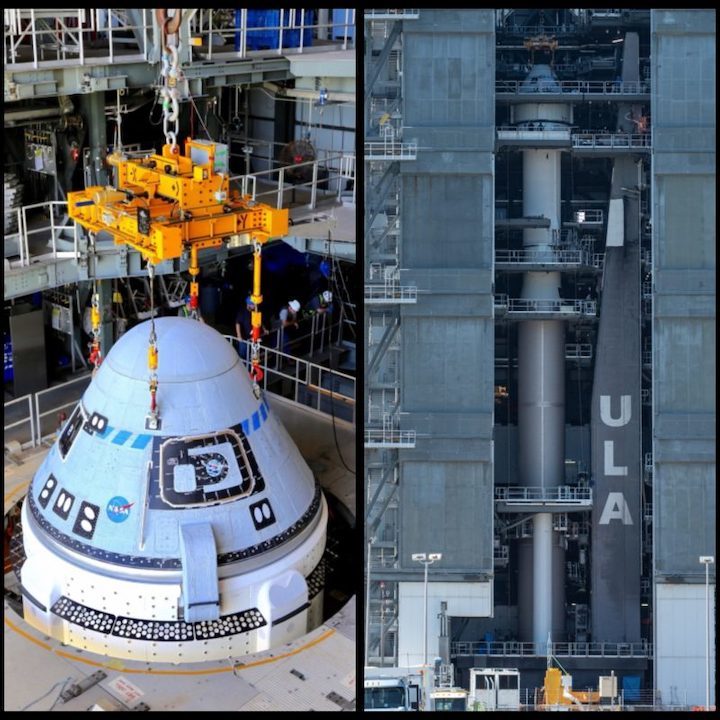
Boeing’s CST-100 Starliner spacecraft is ready to launch again, following a busy weekend where crews transported it from a the company’s Commercial Crew and Cargo Processing Facility at neighboring Kennedy Space Center to Cape Canaveral’s Launch Complex 41 Vertical Integration Facility (VIF), where the United Launch Alliance (ULA) Atlas V rocket tasked with launching the capsule on its second Orbital Flight Test has been waiting.
“Seeing the Starliner atop the Atlas V just days away from launch is symbolic of how proud our team feels about executing this mission,” said John Vollmer, vice president and program manager, Boeing Commercial Crew Program. “OFT-2 is a critical milestone on our path to crewed flights, and we’re all ready to see our hard work come to life with a successful mission from beginning to end.”
Launch is currently targeted for 2:53 p.m. on Friday, July 30, pending a Flight Readiness Review on July 22 by mission leadership at NASA, Boeing and ULA, and pending an upcoming integrated systems test, which is a end-to-end electrical check of the 172-foot-tall Atlas V and Starl


